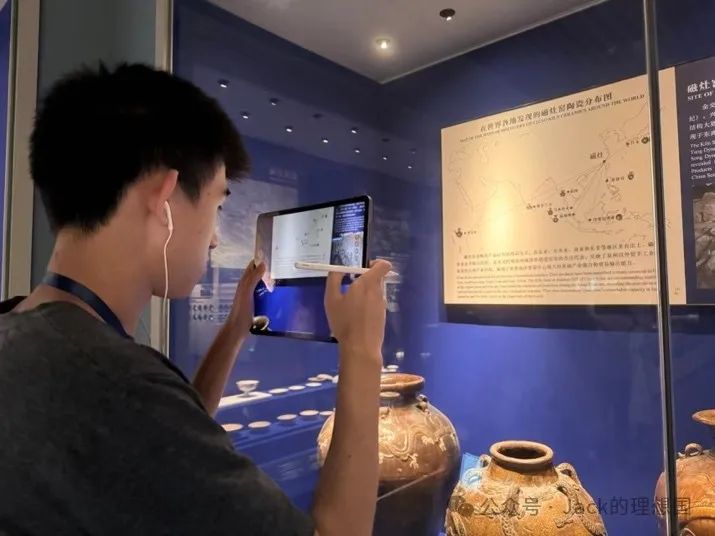Links Between East and West 58 - Quanzhou 2 东西方的连接58 - 泉州2

(The author at the Quanzhou Museum)
The last article analyzed an era of spectacular cultural and religious diversity in the trade city of Quanzhou from the tenth to the early fourteenth century. Like its swift rise to prominence, its unfortunate fall in power merits an examination of its multiple causes. This essay will first consider three arguments, demonstrating the importance of political instability, fiscal deficits, and trade bans enacted during the early Ming Dynasty (1360s-1400s) in damaging the socioeconomic basis on which religious interactions thrived. Then, the essay will compare the fall of Quanzhou to that of other prominent trade hubs, such as Venice, to explore some commonalities between the end of prosperity for trade cities.
First, during the mid-fourteenth century, the Yuan Dynasty suffered from internal discord and destabilizing political events. Though many of these events did not occur directly in Quanzhou, their ripple effects reached the city. For example, a series of peasant revolts in the 1350s scattered across the Yuan Empire, from the northern borders with Manchuria to cities in the less centralized south. Quanzhou itself experienced several riots, causing many merchants and farmers to leave the city. Chinese historical records show that the city’s population plummeted from around 500,000 to 380,000 by 1355. Following this population decline, Quanzhou’s productive capacity shrunk dramatically. Factories and workshops producing porcelain and other exported goods closed. The labor force diminished considerably. The shrinking economic productivity lowered the potential trade volume, dragging down economic growth. Foreign traders moved away from the city in search of more profitable trading spots, effectively ending Quanzhou's religious-cultural diversity era.
(The Quanzhou Qingjing Islamic Mosque)
Aside from political concerns that brought economic ramifications, the Yuan Dynasty’s fiscal situation deteriorated, becoming highly unbalanced during the mid-fourteenth century. To expand its territories and acquire resources, the Yuan government funded many excursions to conquer neighboring regions like modern-day Japan. The budget required was immense. Around 1350, the total spending on the military reached a shocking ten times the total taxation at the zenith of the Tang Dynasty, when the Chinese economy peaked. Such extravagant expenses put an unbearable toll on the government’s finances, disabling it from continuously supporting the development of trade centered around Quanzhou. From the tenth to the thirteenth century, the bureaucratic structure responsible for overseeing the trading activities in Quanzhou partially relied on direct funding from the central government. Therefore, the whole commercial system fractured when the emperor struggled to finance the local Quanzhou bureaucracy. Moreover, though Yuan soldiers were numerous and well-trained, many of these excursions failed. These failures meant that the Yuan government reaped no economic profit from its military endeavors, further deteriorating its financial deficit.
The bans on maritime trade enacted during the Ming Dynasty proved to be the last straw that broke the camel’s back. These bans prohibited all forms of non-governmental trade, only allowing tributes to be sent to the central government from tributary states. Such a policy of seclusion hit southern trade posts like Quanzhou, which was challenging since foreign trade was the lifeline of their economies. For Quanzhou, the volume of its exported goods, such as timber, plummeted, causing many merchants to shut down their businesses due to continuous losses. Additionally, Arabs and Persians – groups that were cornerstones on top of which Quanzhou’s diverse religious communities sprang up – left the city, resulting in a gradual yet complete disintegration of the city’s cultural diversity.
Furthermore, the trade bans produced an unintended consequence that dealt a fatal blow to Quanzhou's significance as a port. After the bans illegalized private trading, many merchants turned to smuggling to seek a means of profit, which, though illegal, provided a source of revenue. During the Ming Dynasty, smuggling became so prevalent that smugglers set up “smuggling ports” along the coastline. These privately established ports rivaled Quanzhou, tempting many merchants to travel to them for trade. As time passed, Quanzhou’s status fell from an indispensable commercial center to a closed, unused city. Consequently, religious traders disappeared from its streets.
Even more long-lasting than the economic ramifications were the cultural ones. The trade bans, in effect, ended the tradition of encouraging commerce and free trade. Since the enactment of the prohibitions, historians at the time only documented Admiral Zheng He’s sailing journeys. To an extent, this suggests that civilians no longer braved the waves, instead returning to conventional means of production: agriculture and the crafts market. The collapse of Quanzhou foreshadowed the end of an era when the Chinese economy strongly linked itself to other Asian and European regions and heralded the dawn of a new age of feudalism when China quarantined itself from the rest of the world.
(The Quanzhou Guandi Temple)
The fall of Quanzhou may seem like an isolated event, an anomaly in recent history. After all, during the fifteenth and sixteenth centuries, international trade boomed with the coming of the Age of Exploration. However, upon closer examination of similar trade hubs, such as Venice, Quanzhou’s fate appeared to bear similarities with that of these prominent cities. Consider Venice, a major maritime and trade power from the Middle Ages through the Renaissance, controlling key trade routes between Europe and the East. During the sixteenth and seventeenth centuries, Venice declined in power and influence. Like Quanzhou, Venice suffered from political instability. Recurrent plague outbreaks, such as the ones from 1575 to 1577 and 1630 to 1631, decimated the population, triggering several unrests. These unrests scared away many merchants, further disrupting economic activity.
Another factor that prompted Venice to decline was economic competition. Before the sixteenth century, Venice monopolized trade by directing routes from Asia through the Mediterranean to Europe. Beginning in the sixteenth century, rising Atlantic powers like Portugal and Spain overshadowed Venice’s trade dominance when they revolutionarily discovered new trade routes to Asia around Africa or between the Americas and Europe. Economic competition thus weakened Venice’s influence. Its fate, hence, shared similarities with that of Quanzhou.
While seemingly unique, Quanzhou's decline reflects broader patterns observed in other significant trade hubs of history, such as Venice. As demonstrated, Quanzhou's fall resulted from a confluence of political instability, fiscal mismanagement, and restrictive trade policies. These factors collectively undermined its economic foundation and, consequently, its rich cultural and religious diversity. Thus, the story of Quanzhou not only offers insights into the specific historical context of medieval China but also serves as a case study of the broader dynamics that can lead to the rise and fall of trade cities across history.
Additionally, Quanzhou’s decline strikes a warning bell for any state today that boasts a seemingly robust economy and diverse culture. A precipitous fall might await any one of the flourishing nations. While there are uncontrollable factors, to continue to flourish, governments must not fall into the trap of isolationism and instead remain open to exchanging goods and values. Quanzhou’s story alludes to the very reason. By adhering to this principle, Quanzhou thrived for over four centuries. And yet, by abandoning this principle, that city “vanished” silently just within a century.
(The author at an exhibition about the historical relationship between Quanzhou and Sri Lanka)
上一篇文章主要分析了从十世纪到十四世纪初泉州这座贸易城市文化宗教多样性的时代特征。与泉州的迅速崛起一样,泉州的衰落也值得历史学家研究其多重原因。本文将探讨三个论点,说明明朝初期(1360-1400 年代)的政治不稳定、财政赤字和贸易禁令在破坏宗教文化互动繁荣的社会经济基础方面的重要性。然后,文章将把泉州的衰落与其他著名贸易中心,例如威尼斯的衰落进行比较,以探讨贸易城市衰败的一些共同之处。
首先,十四世纪中叶,元朝内部不和,政治局势动荡不安。虽然其中许多事件并未直接发生在泉州,但其连锁反应却波及泉州。例如,1350 年代发生的一系列农民起义冲击了整个元帝国,从与满洲接壤的北部边境到中心化程度较低的南部城市。泉州本身也经历了几次暴动,导致许多商人和农民离开城市。中国的历史记录显示,到 1355 年,泉州的人口从约 500,000 人骤降至 380,000 人。随着人口的减少,泉州的生产能力也急剧萎缩。生产瓷器和其他出口商品的工厂和作坊纷纷关闭,劳动力大幅减少。经济生产力的萎缩降低了潜在的贸易量,拖累了经济增长。外国商人纷纷离开泉州,去寻找更有利可图的贸易地点,泉州的宗教文化多元化时代就此结束。
(泉州伊斯兰清净寺)
除了政治问题带来的经济影响,元朝的财政状况也每况愈下,在十四世纪中叶变得极不平衡。为了扩张领土、获取资源,元朝政府多次出兵征服周边地区,如现代的日本,这需要庞大的预算。1350 年前后,军事开支总额达到了唐朝时期,也就是经济最繁荣时期,税收总额的十倍,令人震惊。如此巨额的开支使政府财政不堪重负,无法继续支持以泉州为中心的贸易发展。从十世纪到十三世纪,负责监督泉州贸易活动的官僚机构部分依赖于中央政府的直接拨款。因此,当皇帝无法为泉州当地的官僚机构提供充足的资金时,整个商业体系就出现了断裂。此外,虽然元朝士兵人数众多且训练有素,但许多远征均以失败告终。这些失败意味着元朝政府无法从军事行动中获得经济收益,进一步恶化了财政赤字。
明朝颁布的海上贸易禁令被证明是压垮骆驼的最后一根稻草。这些禁令禁止一切形式的非官方贸易,只允许朝贡国向中央政府进贡。这种闭关锁国的政策打击了泉州等南方贸易站,因为对外贸易是这些贸易站的经济命脉。就泉州而言,其出口货物(如木材)的数量急剧下降,导致许多商业因持续亏损而停业。此外,阿拉伯人、波斯人相继离开泉州,导致其多元文化逐渐瓦解。
此外,贸易海禁还产生了一个意想不到的后果,对泉州作为港口的重要性造成了致命打击。在海禁将私人贸易非法化之后,许多商人转而通过走私谋利,虽然走私是非法的,但却为他们提供了收入来源。在明朝,走私变得非常普遍,走私者在海岸线上建立了 "走私港口"。这些私港可与泉州相竞争,吸引了许多商人转而前往这些港口进行贸易。随着时间的推移,泉州的地位从一个不可或缺的商业中心下降到一个不断封闭、收缩的城市。因此,宗教商人从泉州的街道上消失了。
比经济影响更持久的是文化影响。海禁实际上结束了鼓励商业和自由贸易的传统。自禁令颁布之后,只有郑和下西洋的经历被记载下来。这在一定程度上表明,平民不再冒着风浪出海,而是回到了传统的生产方式:农业和手工业市场。泉州的沦陷预示着中国经济与其他亚洲和欧洲地区紧密联系的时代的终结,也预示着中国与世隔绝的封建主义新时代的到来。
(泉州关帝庙)
泉州的衰落似乎是一个孤立事件,是近代史上的一个反常现象。毕竟,在 15 世纪和 16 世纪,随着探险时代的到来,国际贸易蓬勃发展。然而,仔细研究威尼斯等类似的贸易中心,泉州的命运似乎与这些著名城市有相似之处。从中世纪到文艺复兴时期,威尼斯一直是海上与贸易大国,控制着欧洲和东方之间的主要贸易路线。十六和十七世纪,威尼斯的实力及影响力逐渐衰落。与泉州一样,威尼斯也饱受政治动荡之苦。1575年至1577年和1630年至1631年等瘟疫频发,人口锐减,引发了数次动乱。这些动乱逐走了许多商人,进一步扰乱了经济活动。
促使威尼斯衰落的另一个因素是经济竞争。16 世纪以前,威尼斯垄断了从亚洲经地中海到欧洲的贸易路线。从 16 世纪开始,葡萄牙和西班牙等崛起的大西洋强国通过革命性的方式发现了非洲周边通往亚洲或美洲与欧洲之间的新贸易路线,从而使威尼斯的贸易霸主地位黯然失色,威尼斯的影响力也因经济竞争而被削弱。从这些角度比较,威尼斯的命运与泉州有相似之处。
泉州和威尼斯作为核心贸易城市,由盛转衰的发展历程引人深思:是否所有的贸易城市都注定有失败的一天?如果是这样,那么它们的最终失败更应该归咎于人类的错误选择还是自然的不幸灾难?尽管今天的中国历史学家几乎一致认为贸易禁令是终结泉州繁荣和多元化时代的罪魁祸首,但即使政府做出了正确的决策,泉州是否仍能承受元朝中国不可避免的政治不稳定和人口自然衰退周期的打击?历史学家们很难从这些因素中提取出任何一个,并认为其重要性超过了其他因素,泉州的骤然衰落表明有多种因素共同作用,最终促使经济繁荣与文化多元的时代戛然而止。
泉州的衰落看似是孤立的,却反映了历史上其他重要贸易枢纽(如威尼斯)的广泛发展规律。如上所述,泉州的衰落源于政治动荡、财政管理不善和限制性贸易政策。这些因素共同破坏了泉州的经济基础,进而破坏了其丰富的文化和宗教多样性。因此,泉州的故事不仅让人了解到14与15世纪中国的具体历史背景,还可作为一个案例,使历史学家能够用于研究历史上导致贸易城市兴衰的更广泛的动态因素。
此外,泉州的衰落也为今天任何一个看似经济繁荣、文化多元的国家敲响了警钟:一个蓬勃发展的国家都可能面临一段断崖式的衰落。虽然存在一些不可控因素,但各国政府要想继续繁荣发展,就不能陷入孤立主义的陷阱,而应保持开放的态度,进行商品和文化价值观的持久交流。泉州的故事正暗合了这个道理:坚持这一原则,泉州的经济与文化繁荣了四个多世纪,然而,由于放弃这一原则,泉州的盛况仅在一个世纪内就悄无声息地消失了。
- 本文标签: 原创
- 本文链接: http://www.jack-utopia.cn//article/639
- 版权声明: 本文由Jack原创发布,转载请遵循《署名-非商业性使用-相同方式共享 4.0 国际 (CC BY-NC-SA 4.0)》许可协议授权










